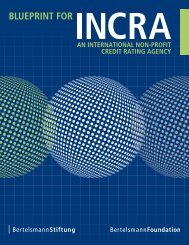III. Track record of past crisis management (if applicable) Is there evidence from historical events that the country and its society have already mastered economic and political shocks in the past? Yes, particularly throughout the last 30 years. During the 1980s and early 1990s, <strong>Brazil</strong> was able fairly successfully to overcome political turmoil, democratic transition, debt default, hyperinflation and the impeachment of its first democratically elected president. Furthermore, the 2008 international financial crisis did comparatively little damage to the <strong>Brazil</strong>ian economy, proving that the country’s financial and political stability is difficult to damage. The <strong>Brazil</strong>ian economy was severely hit by the 2008 crisis. But although deep, the impact of the crisis did not last for a long time. GDP growth experienced a quick recovery, showing that the health of the <strong>Brazil</strong>ian economy was good. The banking system performed very well during the crisis, showing a great deal of resilience. A solid supervision regulation significantly helped the system to avoid the systemic crisis that was a possibility in the <strong>Brazil</strong>ian banking system at the end of 2008. Does the political system facilitate crisis remediation in a timely manner? The institutions established by the 1988 Constitution were indeed capable of remediating the crises that occurred until today in a timely manner. However, the <strong>Brazil</strong>ian political system in itself is difficult to change, as the Constitution can only be amended with a three-‐fifth's majority in both chambers of the legislature, with two rounds of voting in each. For this reason, it is difficult to remediate the very chronic inconsistencies that could be responsible for political crises in <strong>Brazil</strong>, such as corruption and impunity. Is the signaling process between decision makers (government, central bank, employers, employee representatives) so well established that confusion about (and resistance to) the expected outcome of decisions by one decision maker on the others can be avoided or at least minimized? Yes. Following the election of President Lula in 2002, there was general uncertainty about whether the left-‐wing PT administration would continue fiscal and economic policies pursued by former President Fernando Henrique Cardoso, from the centrist PSDB (<strong>Brazil</strong>ian Social Democracy Party). At that time, the <strong>Brazil</strong>ian currency suffered a historical devaluation, the debt crisis escalated and foreign investors observed the <strong>Brazil</strong>ian economy with caution. Stabilization and confidence building with the financial markets were thus high on the political agenda of the Lula government from the start. Lula was able to minimize the confusion about the expected outcome of his decisions by adopting a conservative fiscal policy (in accordance with his antecessor’s) and assuring investors that <strong>Brazil</strong>’s responsibilities towards IMF and foreign investors would be met. Judging by this example, <strong>Brazil</strong>ian decision makers are able to coordinate their activities and minimize confusion by following consistent policies and obtaining international credibility. Are there constitutionally anchored and politically accepted procedures for sequencing and timing countermeasures in a crisis? INCRA <strong>Brazil</strong> <strong>Expert</strong> <strong>Report</strong> 34
Though there are no constitutionally anchored procedures to counteract a crisis, recent <strong>Brazil</strong>ian governments became known for their austerity and pragmatism when dealing with economic instabilities. For instance, the <strong>Brazil</strong>ian Development Band (BNDES) lends money on accessible conditions to farmers and small entrepreneurs. The government also promotes tax cuts, lower interest rates (though <strong>Brazil</strong>ian interest rates remain some of the world’s highest) and long-‐term financing of houses and consumer goods in order to stimulate consumption. Are precautionary measures (e.g., deposit insurances, foreclosure procedures) in place that can protect the most vulnerable groups against the full effect of a crisis? There are indeed precautionary measures in place. Though mortgages and subsequent foreclosure procedures are less frequent, the <strong>Brazil</strong>ian Credit Guarantee Fund (FGC) offers deposit insurance up to R$ 70,000. Social programs (such as “Minha Casa, Minha Vida” or “Bolsa Família”) build housing and provide cash transfers for low-‐income families, minimizing the effects of an eventual crisis. Are automatic stabilizers in fiscal policies sufficiently strong to contain surges of massive unemployment? The improvement of fiscal discipline and credibility in fiscal management has made possible the gradual adoption of countercyclical fiscal stances in recent years. Debt management to reduce the pro-‐cyclicality of fiscal policy has also been an important strategy for reducing exposure to volatile capital flows. The commitment to fiscal discipline, formalized in the Fiscal Responsibility Law enacted in 2000, set constraints on the financing of the public sector, including state-‐controlled financial institutions, and provides for budgetary planning and disclosure rules. Fiscal targets were met every year up to 2009. The <strong>Brazil</strong>ian government’s response to the 2009 international crisis involved protection of financial markets and support to credit, full operation of automatic stabilizers and fiscal stimulus. Fiscal measures pursued by the <strong>Brazil</strong>ian government consistently led to lower unemployment rates (under 6 percent in May 2012) as well as lower taxes and a controlled inflation, in spite of increased government spending. INCRA <strong>Brazil</strong> <strong>Expert</strong> <strong>Report</strong> 35






